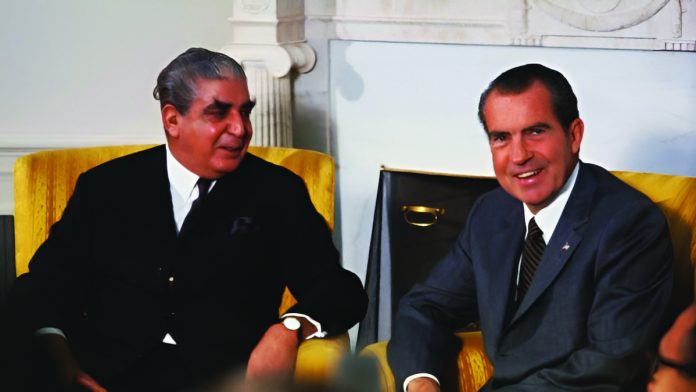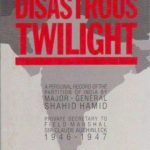Team Interaction
President General Yahya Khan was fully aware that the country’s political environment was becoming increasingly unstable. Progressive and socialist movements were gaining ground, and public pressure for a change in leadership was growing louder. In response, he addressed the nation on television and announced a major decision general elections would be held the following year, and power would be handed over to the elected representatives.
To make way for this transition, President Yahya suspended the 1962 Constitution and introduced a new legal structure called the Legal Framework Order (LFO) of 1970. This order brought significant changes, especially in West Pakistan. One of the major shifts was the abolishment of the ‘One Unit’ scheme, which led to the removal of the “West” label from Pakistan. Provinces were restored to their original status as they were in 1947, and elections would now be held through direct voting, replacing the earlier system of equal representation.
This move also reinstated key state institutions like the parliament, Supreme Court, and central government, giving them back their original roles. However, it’s important to note that these reforms applied only to West Pakistan East Pakistan remained unaffected by these changes. In the lead-up to Pakistan’s first-ever general elections, the political landscape was buzzing with activity. The Election Commission had officially registered 24 political parties, and their rallies drew huge crowds across the country, showing the public’s eagerness to participate in the democratic process. However, just before Election Day, a devastating cyclone hit East Pakistan, claiming around half a million lives. Despite this heartbreaking tragedy, the people’s determination to vote remained strong they were ready to shape their future through the ballot box.
In East Pakistan, the Awami League campaigned hard around its famous Six Points agenda, and gained massive support. Meanwhile, in West Pakistan, Zulfiqar Ali Bhutto’s Pakistan People’s Party (PPP) emerged as a powerful force. With its popular slogan, “roti, kapda aur makaan” (food, clothing, and shelter) and a socialist message, the PPP quickly struck a chord with the working class. On the other side, the conservative Pakistan Muslim League (PML), led by Nurul Amin, focused on religious and nationalist slogans to appeal to voters across the country.
Out of the 313 seats in the National Assembly, the Awami League won a clear majority with 167 seats, all from East Pakistan, while the PPP secured 88 seats, all from West Pakistan. The Awami League had enough seats to form the government on its own, but the political leadership in West Pakistan refused to hand over power to a party based entirely in the East. Talks were initiated to find a middle ground. Bhutto famously remarked, “Udhar tum, idhar hum””You rule there (East), we rule here (West),” suggesting a power-sharing arrangement instead of a unified government. PPP leaders argued that the Awami League lacked any mandate in the western wing of the country.
Though President Yahya Khan invited the Awami League to the National Assembly session in Islamabad, he didn’t officially invite them to form the government, mainly due to Bhutto’s resistance. With no consensus reached, Yahya Khan made a controversial decisionhe appointed Nurul Amin, a Bengali politician known for opposing the independence movement, as Prime Minister and gave him the additional role of the country’s first and only Vice President.
After the political deadlock, Sheikh Mujibur Rahman launched a non-cooperation movement in early 1971 that brought East Pakistan’s government to a standstill. Offices, institutions, and law enforcement stopped working as the Awami League called for civil disobedience. Despite efforts, talks between Sheikh Mujib and Zulfiqar Ali Bhutto failed, and tensions escalated further.
In response, President Yahya Khan decided to take military action. The army launched Operation Searchlight and later Operation Barisal, aimed at restoring order, but these operations resulted in a widespread crackdown against political activists, students, and civilians in East Pakistan. Sheikh Mujib was arrested and secretly brought to Islamabad, while other Awami League leaders fled to India, where they formed a parallel government-in-exile.
Meanwhile, India took a vicious role. With Indian support, a guerrilla group called the Mukti Bahini began attacking Pakistani forces in East Pakistan. As the situation worsened, millions of Bengali Muslims and Hindus fled to India, triggering a humanitarian crisis. Indian Prime Minister Indira Gandhi cunningly began providing military aid to the rebels openly. In March 1971, Major General Ziaur Rahman, speaking on behalf of Sheikh Mujibur Rahman, declared East Pakistan’s independence, naming the new country Bangladesh.
As the conflict intensified, Pakistan’s military launched pre-emptive air strikes on 11 Indian airbases on 3 December 1971, aiming to stop India from interfering. But this move backfiredIndia officially entered the war on the side of the Bangladeshi forces. The Pakistani military in East Pakistan, untrained in guerrilla warfare and isolated from the western wing, struggled to hold their ground. Under the leadership of General Amir Abdullah Khan Niazi and Admiral Muhammad Sharif, the Pakistani forces were gradually pushed back. Overwhelmed, exhausted, and outnumbered, the Eastern Command eventually surrendered in Dhaka on 16 December 1971 to the combined forces of India and the Mukti Bahini.
Despite the surrender, Indian Army Chief Sam Manekshaw later acknowledged that the Pakistani soldiers fought bravely under extremely difficult conditions. Still, the war had a heavy human cost independent researchers estimate around 300,000 civilian deaths during this tragic period. The outcome shook the entire nation. President Yahya Khan resigned, and on 20 December 1971, Zulfiqar Ali Bhutto was sworn in as President and Chief Martial Law Administrator, marking the beginning of a new and difficult chapter in Pakistan’s history.
After the painful fall of East Pakistan, Zulfiqar Ali Bhutto took charge of a broken and grieving nation. One of his very first decisions as the new leader was to release Sheikh Mujibur Rahman, who had been imprisoned in West Pakistan. In his another move, Bhutto also placed former President Yahya Khan under house arrest, holding him accountable for the military and political failures that led to the crisis. Bhutto also dismissed the top military leadership. General Gul Hassan Khan, who was then the Commander-in-Chief of the Pakistan Army, was relieved of his duties. Air Marshal Abdul Rahim Khan of the Air Force and Vice-Admiral Muzaffar Hassan of the Navy were also removed from their positions.
Bhutto then addressed the nation on Pakistan Television (PTV), delivering a powerful and emotional speech that spoke directly to the hearts of his fellow Pakistanis. He acknowledged the pain, confusion, and sorrow felt across the country, and promised a new beginning. To find out the truth behind the war and its devastating outcome, Bhutto ordered the creation of the Hamoodur Rahman Commission, led by Chief Justice Hamoodur Rahman, a respected Bengali judge. The commission was tasked with investigating the causes of the 1971 war and identifying those responsible for the military and political breakdown.
In July 1972, Bhutto made a historic visit to India, where he met with Prime Minister Indira Gandhi. Together, they signed the Shimla Agreement, which laid the foundation for peaceful relations between the two countries. Bhutto managed to bring back the Pakistani soldiers who had been taken as prisoners of war and recovered around 5,000 square miles of Pakistani territory captured by Indian forces. As part of this agreement, Bhutto also formally recognized Bangladesh as an independent country.
On the economic front, Bhutto broke away from the capitalist policies of former President Ayub Khan and introduced a socialist approach. On 2 January 1972, he nationalized major industries across Pakistan iron and steel, heavy machinery, cement, petrochemicals, and more bringing them under state control. This was part of his vision to empower the working class and reduce economic inequality. A new labour policy was also introduced, granting greater rights to workers and giving trade unions more voice and power.
On the strategic front, Zulfiqar Ali Bhutto had been a strong advocate for nuclear deterrence even before he came to power. As early as 1967, he had spoken about the importance of Pakistan having its own nuclear capability to ensure national security, especially in a region where India was rapidly advancing its defense technologies. Soon after taking control of the country in December 1971, Bhutto moved swiftly on this vision. Just a few weeks later, on 20 January 1972, he held a highly secretive meeting in Multan. This meeting brought together some of Pakistan’s most brilliant scientists and engineers, organized at Bhutto’s request by Dr. Abdus Salam, the country’s Nobel Prize-winning physicist and then-Science Adviser to the Prime Minister.
In that meeting, Bhutto made a bold and historic announcement: Pakistan would develop its own nuclear weapons program. He emphasized that Pakistan needed to protect its sovereignty and maintain a balance of power in South Asia. Around the same time in 1972, Pakistan’s intelligence agency, the ISI, discovered that India was close to developing an atomic bomb through its secret nuclear program. This news added urgency to Bhutto’s mission. As a result, the government increased defense and science funding by over 200%, signaling a clear national priority.
In the early years, Dr. Abdus Salam played a key role in laying the foundation of the program. He helped gather a strong team of Pakistani scientists, engineers, and mathematicians, many of whom were working abroad or in different institutions. These experts came together to form the Theoretical Physics Group (TPG)a special weapons division within the Pakistan Atomic Energy Commission (PAEC).
Under Bhutto’s leadership, this team worked on designing the bomb, running complex physics calculations, and laying the groundwork for what would eventually become one of Pakistan’s most defining strategic achievements a credible nuclear deterrent.
As Pakistan entered a new era, the foundation for developing a military nuclear capability was firmly laid. This journey wasn’t just about building a bomb it involved creating an entire system known as the nuclear fuel cycle, which included everything from uranium mining and processing to fuel enrichment, reprocessing, and weapons design.
At the center of this scientific and strategic mission was the Pakistan Atomic Energy Commission (PAEC). On 20 January 1972, during the historic Multan Conference of scientists and engineers, Munir Ahmad Khan was appointed as the new Chairman of PAEC. Before this, he was serving as Director of Nuclear Power and Reactors at the International Atomic Energy Agency (IAEA) in Vienna.
Munir Ahmad Khan was no ordinary official he was a world-renowned expert in plutonium technology. Over time, he became known as the “technical father” of Pakistan’s nuclear program, as recognized by a report from the International Institute of Strategic Studies (IISS), London. Working closely with Zulfikar Ali Bhutto, who is often referred to as the political father of Pakistan’s nuclear project, Khan laid the groundwork for key technologies, especially plutonium reprocessing a crucial step in nuclear weapons development.
While the nation focused on scientific progress, it was also transitioning politically. After the tragic loss of East Pakistan, the first session of the new National Assembly was finally held on 14 April 1972 at the State Bank Building in Islamabad. This session brought together 144 Members from West Pakistan and two members from former East Pakistan Nurul Amin and Raja Tridev Roy, who had chosen to remain with Pakistan.
Soon after, on 17 April 1972, the National Assembly adopted an Interim Constitution, which introduced a Presidential form of government for the time being. It was also decided that this setup would continue at least until 14 August 1973. This interim arrangement clearly defined the division of powers between the Centre and the Provinces a critical step in maintaining balance and unity in the post-1971 scenario.
On the same day, a Constitution Committee was formed to draft a permanent Constitution for the country. After months of deliberation, the draft Constitution was submitted on 31 December 1972. It was unanimously passed by the Assembly on 10 April 1973, authenticated by the President two days later, and finally came into effect on 14 August 1973Pakistan’s Independence Day.
This new 1973 Constitution introduced a parliamentary form of government, where the Prime Minister became the head of the executive, and the President served as a ceremonial symbol of unity. On that historic day, Zulfikar Ali Bhutto took oath as the first elected Prime Minister, while Fazal Elahi Chaudhry became the President of Pakistan.
Continue…







